TOYOTA AVENSIS 2014 Owners Manual (in English)
Manufacturer: TOYOTA, Model Year: 2014, Model line: AVENSIS, Model: TOYOTA AVENSIS 2014Pages: 776, PDF Size: 33.54 MB
Page 711 of 776
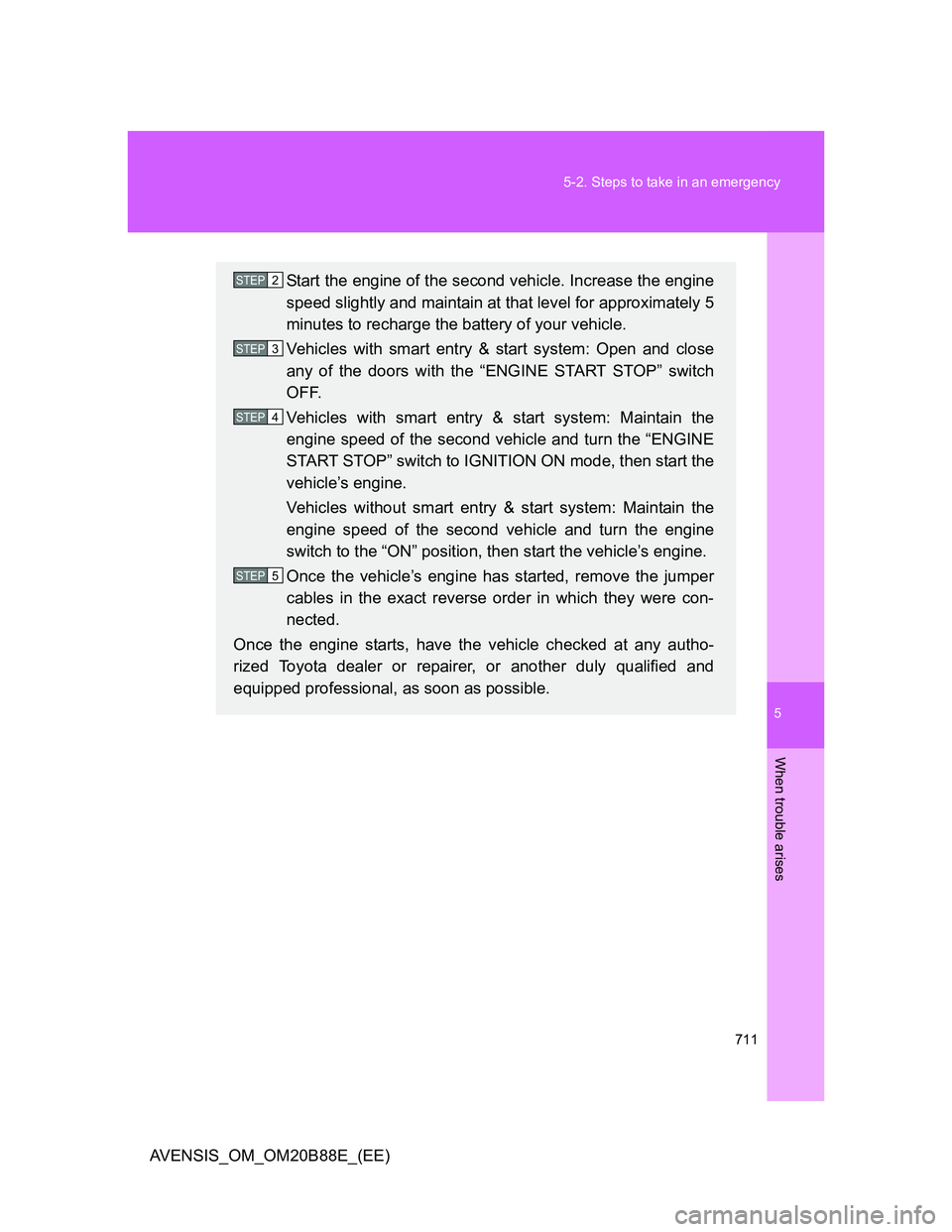
5
711 5-2. Steps to take in an emergency
When trouble arises
AVENSIS_OM_OM20B88E_(EE)
Start the engine of the second vehicle. Increase the engine
speed slightly and maintain at that level for approximately 5
minutes to recharge the battery of your vehicle.
Vehicles with smart entry & start system: Open and close
any of the doors with the “ENGINE START STOP” switch
OFF.
Vehicles with smart entry & start system: Maintain the
engine speed of the second vehicle and turn the “ENGINE
START STOP” switch to IGNITION ON mode, then start the
vehicle’s engine.
Vehicles without smart entry & start system: Maintain the
engine speed of the second vehicle and turn the engine
switch to the “ON” position, then start the vehicle’s engine.
Once the vehicle’s engine has started, remove the jumper
cables in the exact reverse order in which they were con-
nected.
Once the engine starts, have the vehicle checked at any autho-
rized Toyota dealer or repairer, or another duly qualified and
equipped professional, as soon as possible.STEP2
STEP3
STEP4
STEP5
Page 712 of 776
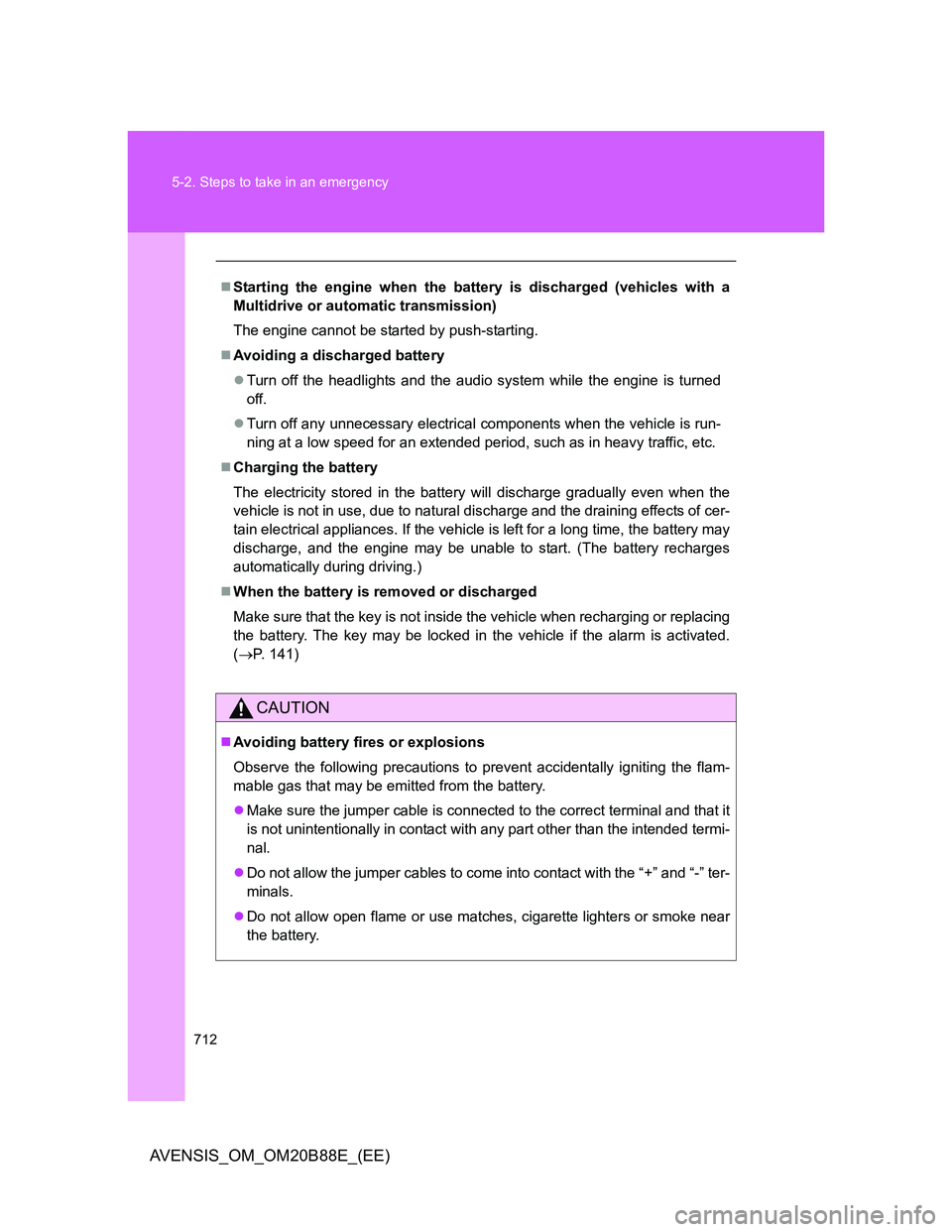
712 5-2. Steps to take in an emergency
AVENSIS_OM_OM20B88E_(EE)
Starting the engine when the battery is discharged (vehicles with a
Multidrive or automatic transmission)
The engine cannot be started by push-starting.
Avoiding a discharged battery
Turn off the headlights and the audio system while the engine is turned
off.
Turn off any unnecessary electrical components when the vehicle is run-
ning at a low speed for an extended period, such as in heavy traffic, etc.
Charging the battery
The electricity stored in the battery will discharge gradually even when the
vehicle is not in use, due to natural discharge and the draining effects of cer-
tain electrical appliances. If the vehicle is left for a long time, the battery may
discharge, and the engine may be unable to start. (The battery recharges
automatically during driving.)
When the battery is removed or discharged
Make sure that the key is not inside the vehicle when recharging or replacing
the battery. The key may be locked in the vehicle if the alarm is activated.
(P. 141)
CAUTION
Avoiding battery fires or explosions
Observe the following precautions to prevent accidentally igniting the flam-
mable gas that may be emitted from the battery.
Make sure the jumper cable is connected to the correct terminal and that it
is not unintentionally in contact with any part other than the intended termi-
nal.
Do not allow the jumper cables to come into contact with the “+” and “-” ter-
minals.
Do not allow open flame or use matches, cigarette lighters or smoke near
the battery.
Page 713 of 776
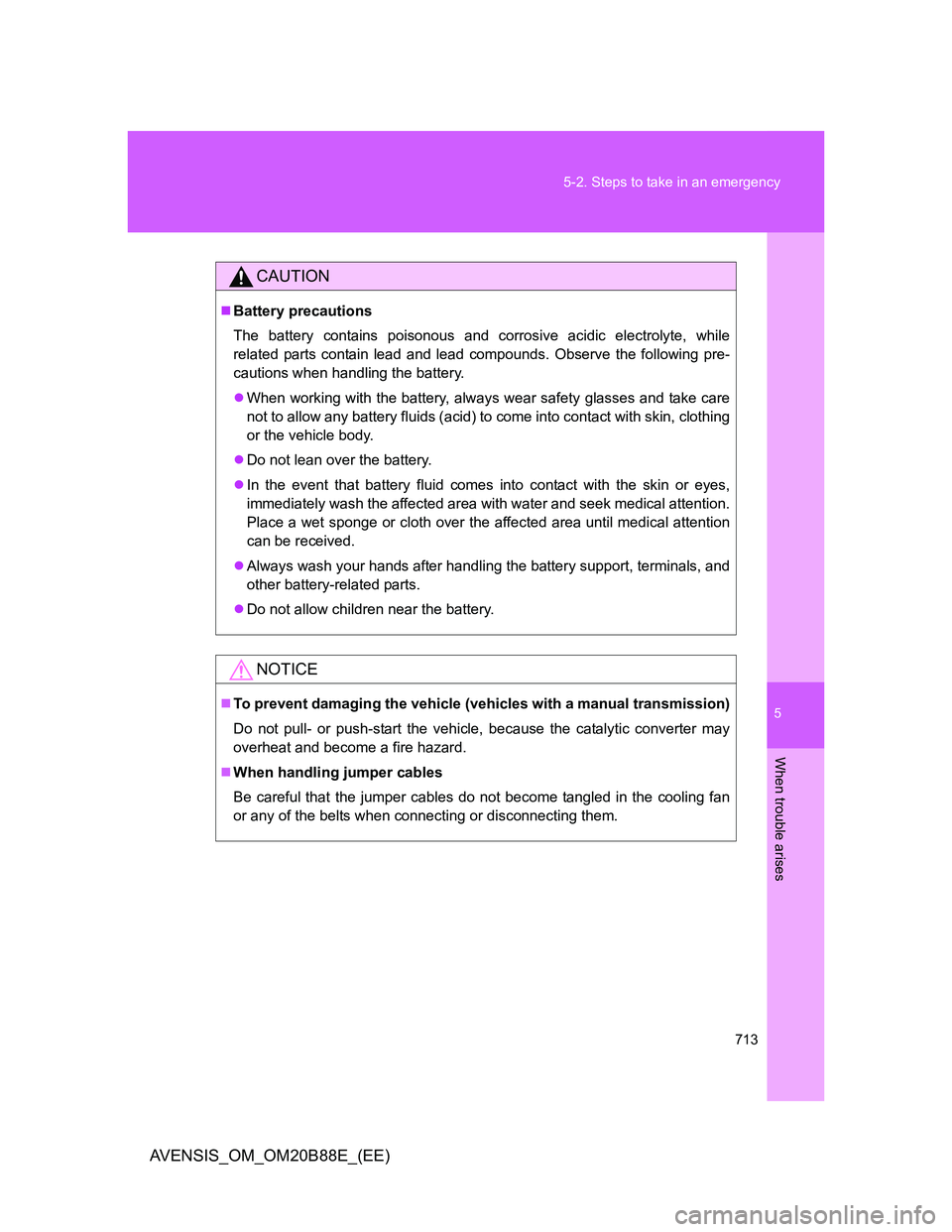
5
713 5-2. Steps to take in an emergency
When trouble arises
AVENSIS_OM_OM20B88E_(EE)
CAUTION
Battery precautions
The battery contains poisonous and corrosive acidic electrolyte, while
related parts contain lead and lead compounds. Observe the following pre-
cautions when handling the battery.
When working with the battery, always wear safety glasses and take care
not to allow any battery fluids (acid) to come into contact with skin, clothing
or the vehicle body.
Do not lean over the battery.
In the event that battery fluid comes into contact with the skin or eyes,
immediately wash the affected area with water and seek medical attention.
Place a wet sponge or cloth over the affected area until medical attention
can be received.
Always wash your hands after handling the battery support, terminals, and
other battery-related parts.
Do not allow children near the battery.
NOTICE
To prevent damaging the vehicle (vehicles with a manual transmission)
Do not pull- or push-start the vehicle, because the catalytic converter may
overheat and become a fire hazard.
When handling jumper cables
Be careful that the jumper cables do not become tangled in the cooling fan
or any of the belts when connecting or disconnecting them.
Page 714 of 776
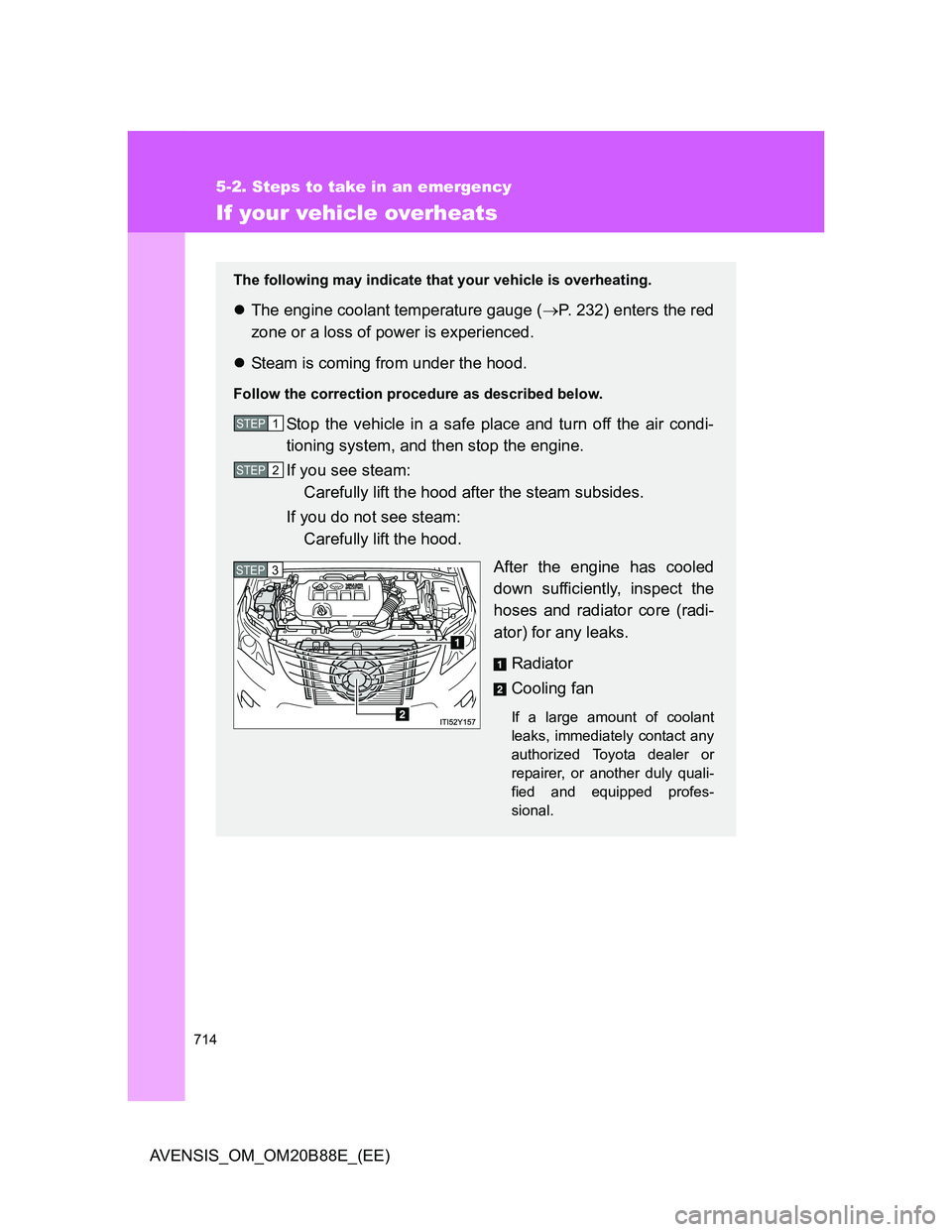
714
5-2. Steps to take in an emergency
AVENSIS_OM_OM20B88E_(EE)
If your vehicle overheats
The following may indicate that your vehicle is overheating.
The engine coolant temperature gauge (P. 232) enters the red
zone or a loss of power is experienced.
Steam is coming from under the hood.
Follow the correction procedure as described below.
Stop the vehicle in a safe place and turn off the air condi-
tioning system, and then stop the engine.
If you see steam:
Carefully lift the hood after the steam subsides.
If you do not see steam:
Carefully lift the hood.
After the engine has cooled
down sufficiently, inspect the
hoses and radiator core (radi-
ator) for any leaks.
Radiator
Cooling fan
If a large amount of coolant
leaks, immediately contact any
authorized Toyota dealer or
repairer, or another duly quali-
fied and equipped profes-
sional.
STEP1
STEP2
STEP3
Page 715 of 776
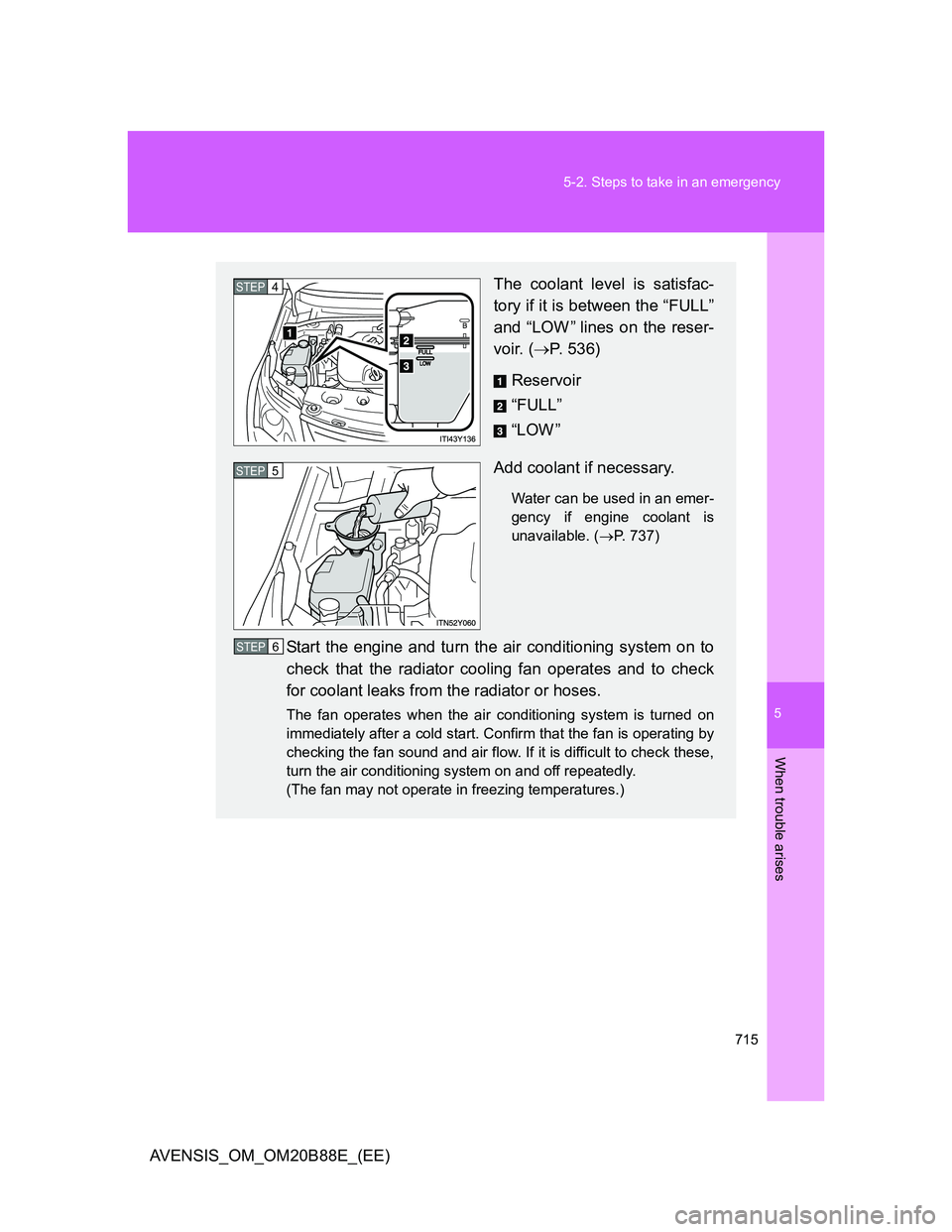
5
715 5-2. Steps to take in an emergency
When trouble arises
AVENSIS_OM_OM20B88E_(EE)
The coolant level is satisfac-
tory if it is between the “FULL”
and “LOW ” lines on the reser-
voir. (P. 536)
Reservoir
“FULL”
“LOW ”
Add coolant if necessary.
Water can be used in an emer-
gency if engine coolant is
unavailable. (P. 737)
Start the engine and turn the air conditioning system on to
check that the radiator cooling fan operates and to check
for coolant leaks from the radiator or hoses.
The fan operates when the air conditioning system is turned on
immediately after a cold start. Confirm that the fan is operating by
checking the fan sound and air flow. If it is difficult to check these,
turn the air conditioning system on and off repeatedly.
(The fan may not operate in freezing temperatures.)
STEP4
STEP5
STEP6
Page 716 of 776
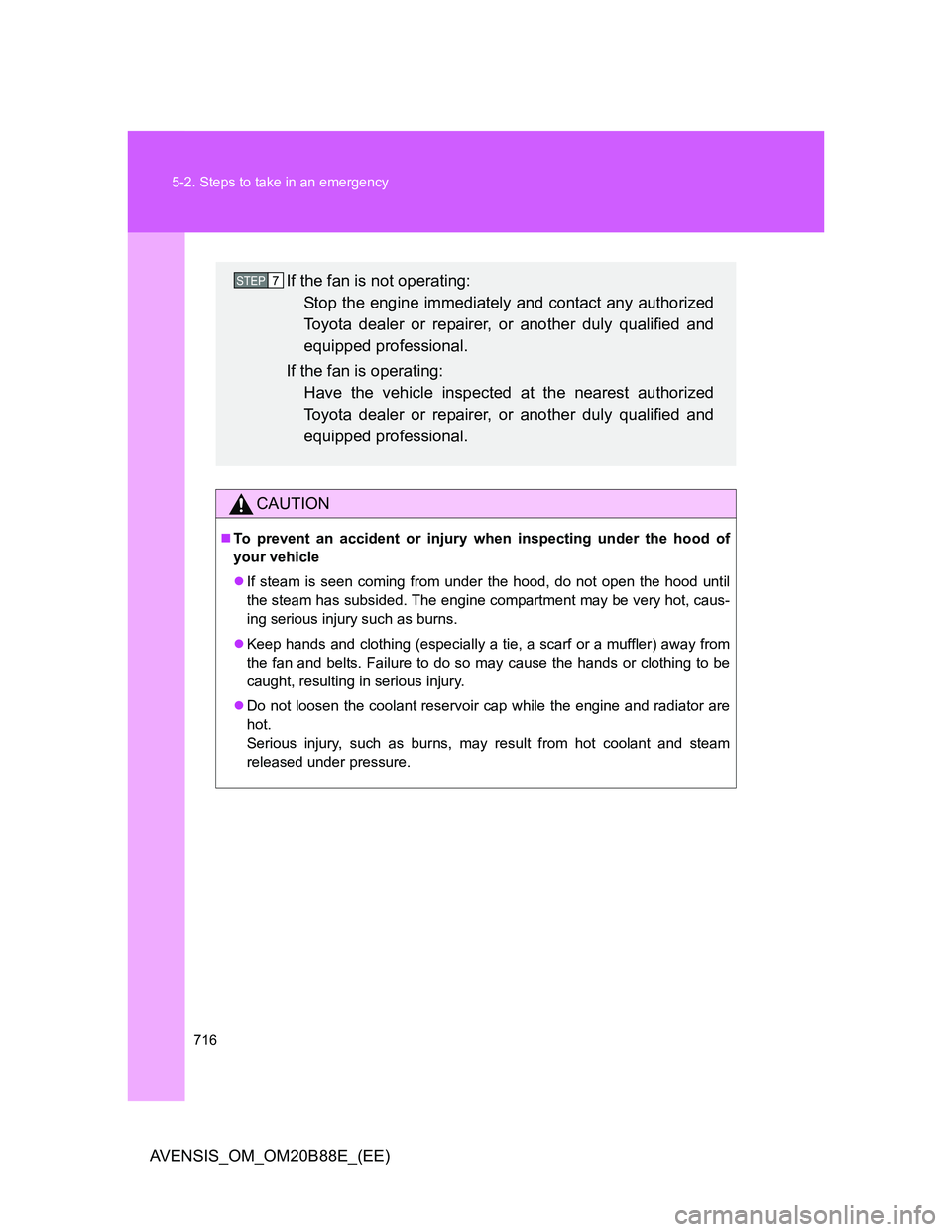
716 5-2. Steps to take in an emergency
AVENSIS_OM_OM20B88E_(EE)
CAUTION
To prevent an accident or injury when inspecting under the hood of
your vehicle
If steam is seen coming from under the hood, do not open the hood until
the steam has subsided. The engine compartment may be very hot, caus-
ing serious injury such as burns.
Keep hands and clothing (especially a tie, a scarf or a muffler) away from
the fan and belts. Failure to do so may cause the hands or clothing to be
caught, resulting in serious injury.
Do not loosen the coolant reservoir cap while the engine and radiator are
hot.
Serious injury, such as burns, may result from hot coolant and steam
released under pressure.
If the fan is not operating:
Stop the engine immediately and contact any authorized
Toyota dealer or repairer, or another duly qualified and
equipped professional.
If the fan is operating:
Have the vehicle inspected at the nearest authorized
Toyota dealer or repairer, or another duly qualified and
equipped professional.STEP7
Page 717 of 776
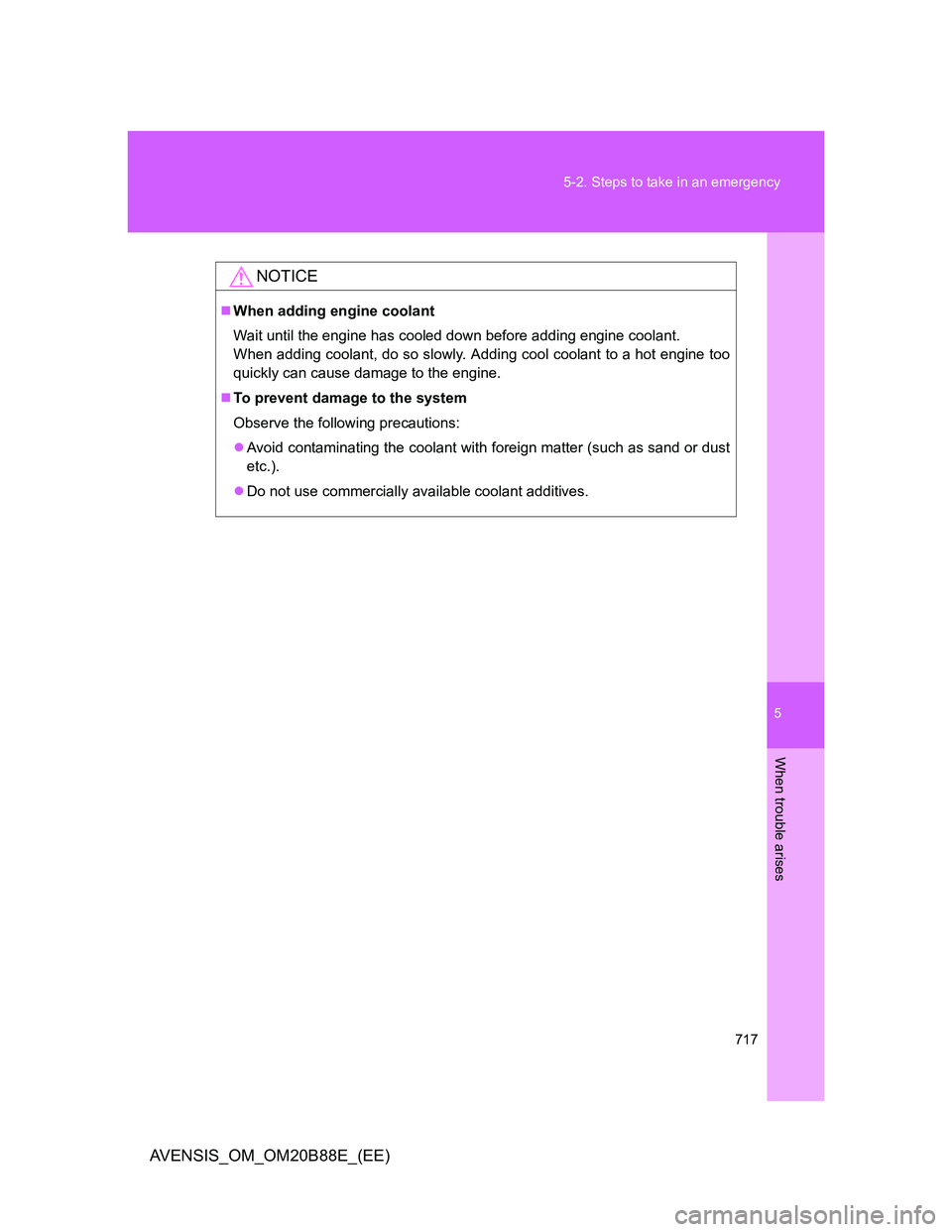
5
717 5-2. Steps to take in an emergency
When trouble arises
AVENSIS_OM_OM20B88E_(EE)
NOTICE
When adding engine coolant
Wait until the engine has cooled down before adding engine coolant.
When adding coolant, do so slowly. Adding cool coolant to a hot engine too
quickly can cause damage to the engine.
To prevent damage to the system
Observe the following precautions:
Avoid contaminating the coolant with foreign matter (such as sand or dust
etc.).
Do not use commercially available coolant additives.
Page 718 of 776
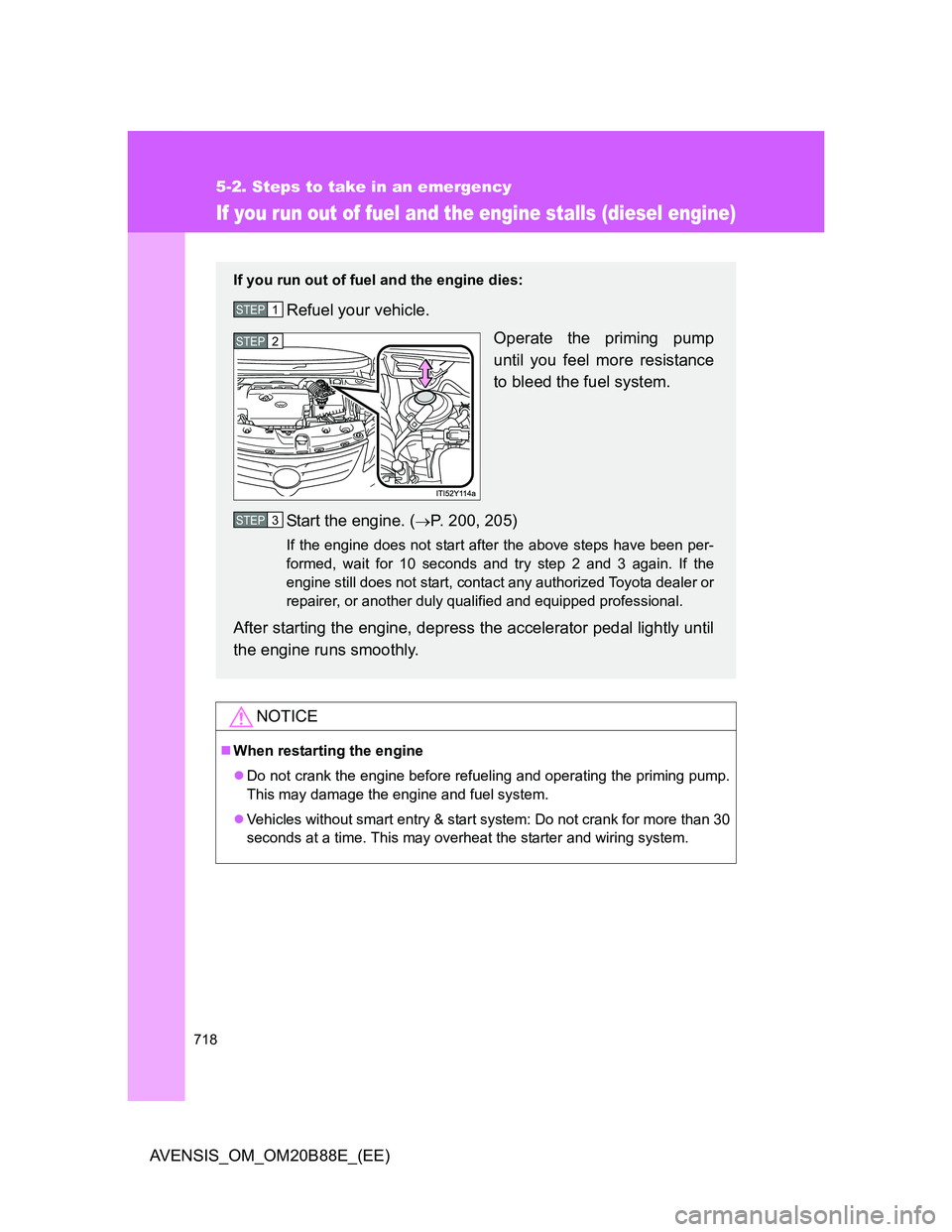
718
5-2. Steps to take in an emergency
AVENSIS_OM_OM20B88E_(EE)
If you run out of fuel and the engine stalls (diesel engine)
NOTICE
When restarting the engine
Do not crank the engine before refueling and operating the priming pump.
This may damage the engine and fuel system.
Vehicles without smart entry & start system: Do not crank for more than 30
seconds at a time. This may overheat the starter and wiring system.
If you run out of fuel and the engine dies:
Refuel your vehicle.
Operate the priming pump
until you feel more resistance
to bleed the fuel system.
Start the engine. (
P. 200, 205)
If the engine does not start after the above steps have been per-
formed, wait for 10 seconds and try step 2 and 3 again. If the
engine still does not start, contact any authorized Toyota dealer or
repairer, or another duly qualified and equipped professional.
After starting the engine, depress the accelerator pedal lightly until
the engine runs smoothly.
STEP1
STEP2
STEP3
Page 719 of 776
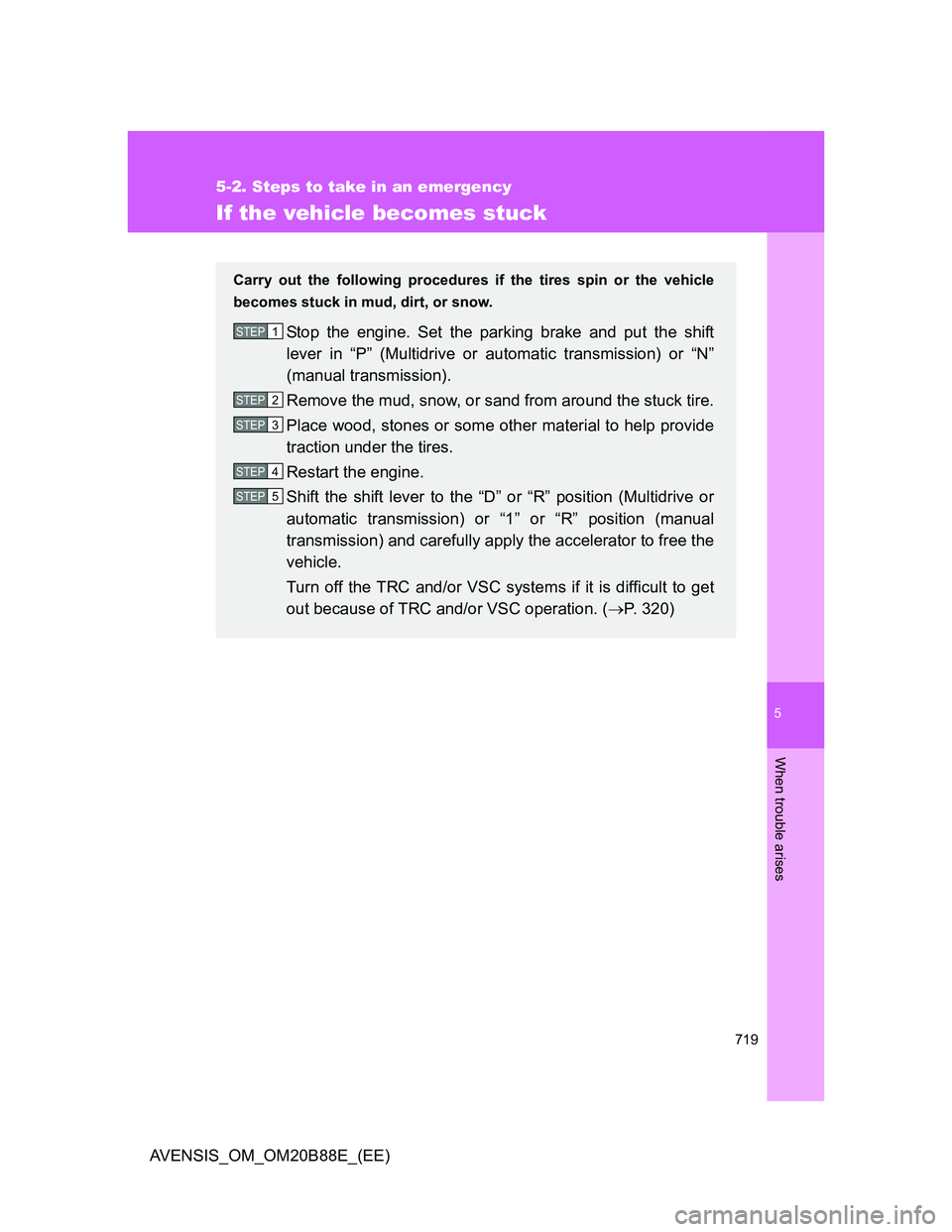
5
719
5-2. Steps to take in an emergency
When trouble arises
AVENSIS_OM_OM20B88E_(EE)
If the vehicle becomes stuck
Carry out the following procedures if the tires spin or the vehicle
becomes stuck in mud, dirt, or snow.
Stop the engine. Set the parking brake and put the shift
lever in “P” (Multidrive or automatic transmission) or “N”
(manual transmission).
Remove the mud, snow, or sand from around the stuck tire.
Place wood, stones or some other material to help provide
traction under the tires.
Restart the engine.
Shift the shift lever to the “D” or “R” position (Multidrive or
automatic transmission) or “1” or “R” position (manual
transmission) and carefully apply the accelerator to free the
vehicle.
Turn off the TRC and/or VSC systems if it is difficult to get
out because of TRC and/or VSC operation. (P. 320)STEP1
STEP2
STEP3
STEP4
STEP5
Page 720 of 776
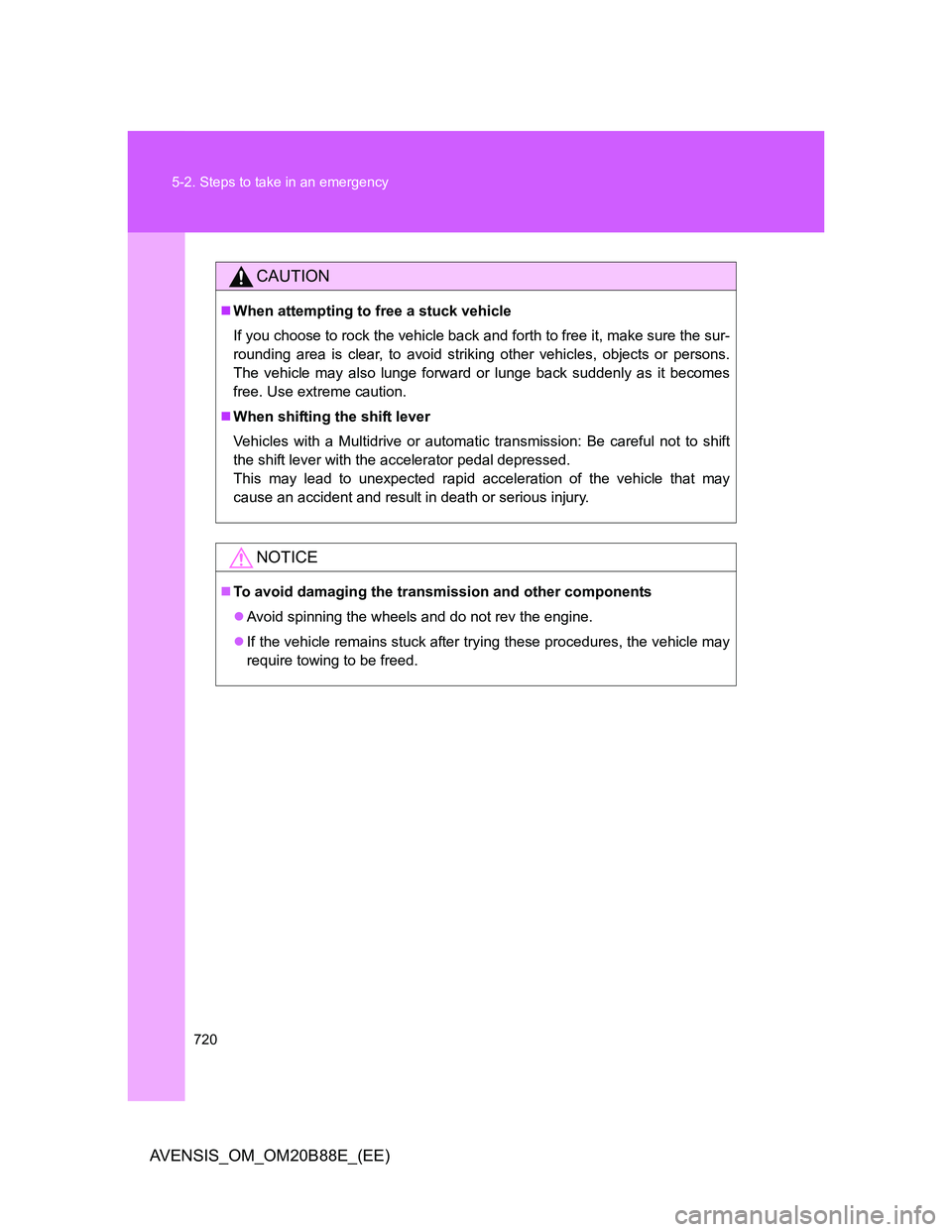
720 5-2. Steps to take in an emergency
AVENSIS_OM_OM20B88E_(EE)
CAUTION
When attempting to free a stuck vehicle
If you choose to rock the vehicle back and forth to free it, make sure the sur-
rounding area is clear, to avoid striking other vehicles, objects or persons.
The vehicle may also lunge forward or lunge back suddenly as it becomes
free. Use extreme caution.
When shifting the shift lever
Vehicles with a Multidrive or automatic transmission: Be careful not to shift
the shift lever with the accelerator pedal depressed.
This may lead to unexpected rapid acceleration of the vehicle that may
cause an accident and result in death or serious injury.
NOTICE
To avoid damaging the transmission and other components
Avoid spinning the wheels and do not rev the engine.
If the vehicle remains stuck after trying these procedures, the vehicle may
require towing to be freed.